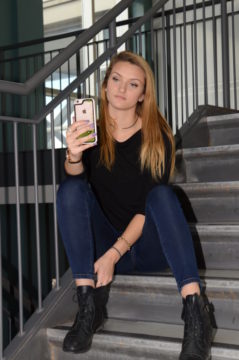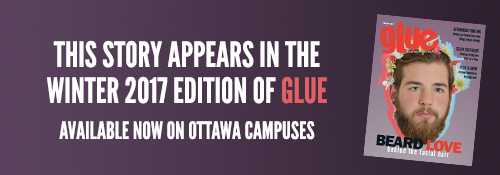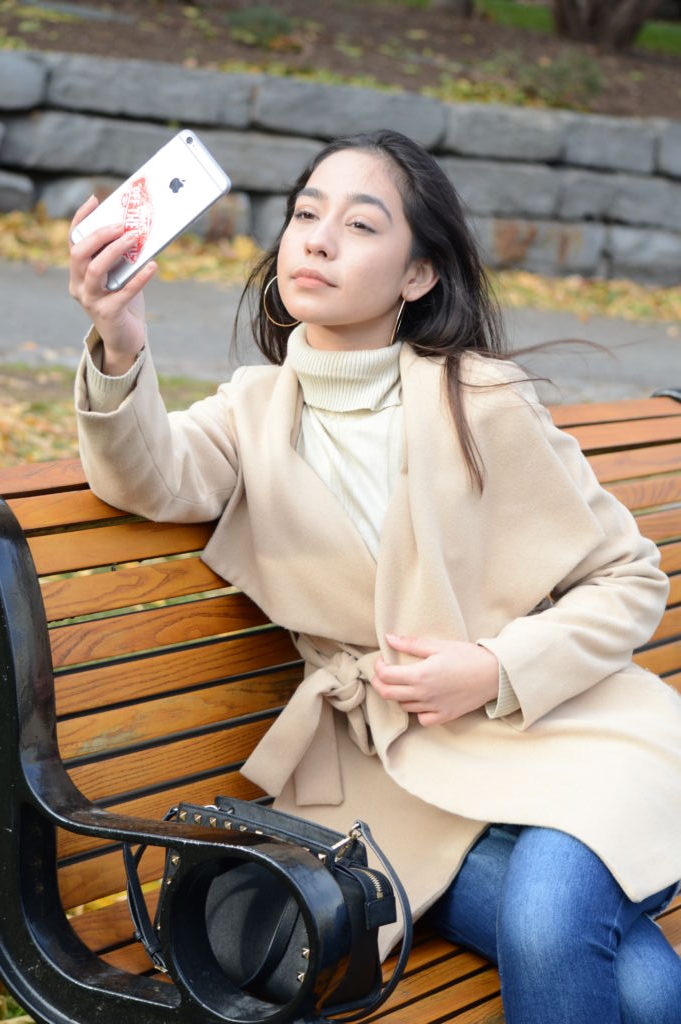Social media can be a fun way to express yourself. For some entrepreneurs, it’s also a way to make money. These four women are building careers on the selfies they post.
University of Ottawa student Emily Devita Johnston has always been one step ahead in the game of life.
While some girls were packing away their dolls in the sixth grade, she was jumping head-first into the world of social media and entrepreneurship in her home country of Indonesia.
It all started when she uploaded a video compiled of short clips of herself and friends goofing around to a catchy pop-rock song and then took to Twitter to express her thoughts. Soon enough, hordes of young Indonesian girls drawn to Johnston’s rebellious attitude and quirky personality flocked to her various social media platforms.
She didn’t know it at the time, but within less than a year, the Jakarta resident would be transformed from a normal girl into an internet celebrity building an empire as a social media mogul.
Some may find it hard to comprehend that non-Kardashian/Jenners can find fame and fortune on social media, but Johnston is living proof that this phenomenon is more common than you may think. In a time where good paying jobs are scarce for millennials, several other young Ottawa residents and students are starting to see the benefits of this lifestyle and are utilizing different platforms to make money and build their own empires from scratch.
“It didn’t start off with me thinking, ‘Yo, I want to profit from this’,” Johnston says casually sitting across the table in the bustling Rideau Centre food court. “When I was in grade six, I was just playing around with videos on YouTube. I was on Twitter a lot and I got a lot of attention from there.”
With her poised demeanour, fresh face, Rapunzel-like silky black hair, tight jeans and leather motorcycle jacket, the young globetrotter appears as if she has stepped straight out of her Instagram account.
Although she doesn’t look a day over her 18 years, when she speaks, her voice and confidence match that of an empowered and seasoned businesswoman.
“Now I have a whole entire system of how to charge people,” says Johnston. “I manage myself as if I was my own business, whereas back then it was completely for fun.”
She eventually went dormant on YouTube for a few years and has since switched over to Instagram where most of her following now lives. She amassed enough of a following on the photo sharing app that it became her part time job as she receives steady income from Indonesian companies who send her items to take photos with.
Clearly, Johnston is quite good at what she does because her audience had grown so exponentially by the time she was wrapping up high school that she was able to support herself with the money she was making from social media. And while most people her age were earning minimum wage working part-time jobs, social media gave Johnston the opportunity to be financially independent and live alone in her own apartment before she had even graduated.
She even ventured into the Indonesian music scene by starring in a music video and recording her own hip-hop song that charted in Malaysia.
“It was really fun, and I was travelling with all the money I made,” she says.
Now living in Ottawa since September 2016 and working towards a psychology degree, Johnston has amassed more than 215,000 followers on Instagram, 25,000 on Snapchat and 439,432 views on her YouTube channel.

Sam May
The concept of using social media as a part time job isn’t as widespread in Canada just yet so most of her audience remains back at home. However, a surge in over 100,000 followers since her move may be indicative of a changing landscape.
Similar to Johnston, Ottawa-based fitness and lifestyle Instagrammer, Emilie Loubier developed a massive following on the app in a relatively short period of time. Her following grew from 1,300 to 80,100 in the past year and she is already beginning to see the money and sponsorships roll in.
She says she is very picky about who she works with and has already turned down offers. Because of this, she has only taken one sponsorship but this could change in the future.
“In all cases, whether I actively seek out a promotional opportunity or passively receive an offer, I conduct a thorough background check on the company and its specific products to ensure that all aspects –the company’s overall message, its reputation, the type of content it posts to social media, and the quality of the products–agree with the kind of content that I post, the message I’m trying to promote, my own personal values, etcetera.”
Although Johnston and Loubier have wide audiences, it’s not just users with massive followings who profit from social media. Those with audiences ranging from 3,000 all the way up to 100,000 are profiting as well.
On the lower end of the spectrum is Sam May, a first-year child and youth care worker student at Algonquin College and part-time model. She doesn’t yet have the audience of the other two, but she does have an impressive 4,192 Instagram followers. For May, building a massive following wasn’t intentional, but she is excited about the prospect of growing her audience and earning revenue through sponsorships.
“I’ve had XO Water company wanting me to do something for them but I wasn’t 18 at the time,” she says. “But I get a lot of offers.”
And then there is florist and former University of Ottawa philosophy student Leah Gibson with around 20,000 followers on Instagram. She theoretically fits into the Insta-famous mould, but plays by her own unique set of rules. She lives life relatively off the grid and says she doesn’t have internet or television at home and that Instagram is her only connection to the online world. But what sets Gibson apart from the rest of the pack isn’t just her bohemian style and attitude, but the fact that she consciously doesn’t profit from social media. Instead, she uses the platform to support and collaborate with friends or small and local businesses saying that she’ll do “any little thing I can do to help out a friend, and as long as it’s a product I’m stoked on and can get behind.”
And although she says some of the larger “small” businesses do send her free items, she considers it to be payment in itself. She just doesn’t feel comfortable with accepting any compensation from smaller companies, whether it be monetary or free items.
“If it’s a friend of mine, they’ll give me like a friend discount but I still don’t feel comfortable not paying them, so I still want to support them; I pay them,” she says.
But she does still get plenty of offers from big companies looking for advertising.
“I turn them down more often than not because that’s just not what I’m about,” says Gibson. “Like I do see it as a form of marketing to a certain extent, but it’s not an outlet for advertising for me. It’s more of a creative hub to kind of interact with people who have like-minded goals. It’s more a way for me to connect with passionate people rather than corporations.”
But for those who do profit, both Loubier and Johnston say that one of the main benefits is the control and empowerment that comes from being popular on social media.
“I’ve never liked being controlled and that’s something I feel like is nice. That what I do, I have full control,” says Johnston.
Although Loubier only has one sponsor at the moment, she says that she enjoys the freedom she has to personalize sponsored content. When it comes to maintaining control over one’s revenue stream, Instagram and YouTube are ideal because they allow content creators to set their own terms and allow them to become a part of this new generation of internet entrepreneurs. However, with YouTube’s partnership with Google AdSense, the process for making money is simplified and can result in a higher intake which is why Johnston is starting to shift her focus back over to videos.
“I’m actually getting more into YouTube now because if endorsements don’t work–it’s quite complex–making money off of YouTube is much easier,” Johnston explains. “[Instagram] It’s just more work now. It’s not as easy as it was then.”
So how is it that in a celebrity obsessed culture, these seemingly ordinary women are gaining celebrity sized audiences and sponsorships?
May says she isn’t quite sure how she amassed such a following, but she has always put work into ensuring her photos are visually appealing.
“I tried to make my whole profile look good, like just pleasing to look at,” she says. “I do my best not to post things that people will be like ‘oh, that’s stupid, I’m going to unfollow her now’.”
But for Loubier, she knows exactly what prompted her account to grow so quickly. Last spring, she enlisted her boyfriend to help take professional looking photos and one in particular sparked a lot of interest.
“My boyfriend captured a black and white photo of me standing in a field that received a lot of attention on my account,” says Loubier.
The photo itself is a simple shot of Loubier dressed in a casual jeans and a tank top staring off into the distance. It didn’t exactly fit in with her fitness theme, but her use of hashtags like #girlswithmuscle, #girlsthatlift and #girlswithtattoos brought people over to her page.
“From there I started gaining hundreds of new followers everyday.”
With tens of thousands of followers and counting, it’s easy for some to only see numbers when looking at their follower counts. But for these women, social media isn’t just about analytics and financial reward. It’s driven by humans seeking a connection with people they follow, whether it be on the internet or in real life.
“I’ve become more motivated to maintain a healthy lifestyle knowing that so many people are seeing and responding to my content.” -Emilie Loubier
For Johnston, interacting with followers is not only important for her to maintain her authenticity, but has also become another way to grow her brand.
“I have an account on this website called ASK fm and I’m actually verified and they give me merch,” she explains. “Me and ASK fm, we have a relationship together. They actually acknowledge my presence there which is really nice.”
She explains that the website allows her followers to submit questions for her to answer and provides a more personal means of communication. Whether it be relationship or life advice, inquiries about her personal life, or even just showering her with compliments, Johnston’s followers ask her anything and everything. And she always answers.
“It’s getting to know me more than it’s just clicking on my picture and this perception of who I am,” says Johnston. “It’s so personal!” she adds joyously.
However, this also means she has the ability to influence thousands of people which is something she has struggled to wrap her head around.
“It’s terrifying, the fact that you’re held liable to whatever you put online,” says Johnston. “It’s scary to see your own influence. The fact that I would be doing something then I would see other people following it-I just don’t want to screw up.”
She also goes on to say that the lines between the computer screen and real life can sometimes cross over resulting in some interesting experiences. Often, when Johnston would go out to concerts and raves back home, she received a lot of attention from people asking for pictures which she says was cool to experience but became overwhelming at times.
“It’s nice here because I don’t have to worry. In Jakarta people actually faint,” she says with mix of concern and laughter. “I’m like, ‘don’t do that!’ I feel so bad.”
Even for those based in Ottawa, the experience can be similar.
May, who has a much smaller following, goes through the same thing.
“When I go places, people know who I am. They’ll be like, ‘You’re Sam!’ and I’ll be like, ‘I don’t know you’,” she says with a laugh. “It’s kind of weird, but like, it’s still kind of cool.”
Not all interactions are the same though. For those with an active social media presence, some followers don’t realize that they are people with real lives outside of Instagram, which can be a bit jarring.
“I get a lot of random people that kind of won’t leave me alone,” says May. “They’ll be like ‘Oh, I saw you downtown yesterday,’ and I’m like ‘I actually have no idea who you are’.”
And the same goes for Johnston. Following a public breakup with her boyfriend, she noticed her male fan base was increasing which resulted in a terrifying experience.
“I remember being followed back to my home in Jakarta which was really scary,” she says. “I got a message and the guy said, ‘is this your plate number?’… That got really scary.”
Loubier and Johnston both say that they experience doubts about their lifestyles and struggle to balance out the positive and negative aspects. However, they also have different perspectives on what that means. For Loubier, this includes pressure to consistently post likeable content and the sense of competition in the Instagram community. However, she adds that the cons are balanced out by the pros.

Leah Gibson
“On the one hand, I’m able to reach a lot of people with my messages of positivity,” she says. “It’s encouraging to see the warm responses I get when I post photos that I’ve worked hard on and am proud of and I’ve become more motivated to maintain a healthy lifestyle knowing that so many people are seeing and responding to my content.”
Johnston’s main struggle is coming to terms with building her life around something she considers superficial, which is why she moved to Ottawa to further her education in the first place.
“I could have sustained myself, I could have made it a career, but it just felt very superficial,” she says. “Just the fact that the entire basis of what I do is physical. And I know a lot of people are comfortable with it, but I just didn’t feel like it satisfied (me).”
Despite this, Loubier, Johnston, May and Gibson all see social media in their future, but remain unsure as to how big of a role it will play.
“It’s quite difficult for me to predict what my future in social media will be,” says Loubier. “Growing my account and increasing my social media visibility is just one priority amongst many others that I have these days. In saying this, I hope that my Instagram will continue to grow so that I can reach out to, and motivate more, people.”
When asked how she sees her future, Johnston admits that while she sometimes has her doubts about the lifestyle, she will not be going off the grid any time soon.
“I was thinking about that, that if I were to move, does that mean I just put an end to social media entirely?” she says. “I am making money and this money did take me this far. It did get me to travel and I enjoy doing it.”
Johnston hopes to continue spreading her influence and looks forward to what Ottawa has in store for herself and the rest of the Instagram community.
“I feel like there is so much potential money to make here,” she says excitedly. “It’s just that one step of actually pressing that post button.”
Follow Nicole McCormick and Glue Magazine on Twitter.

